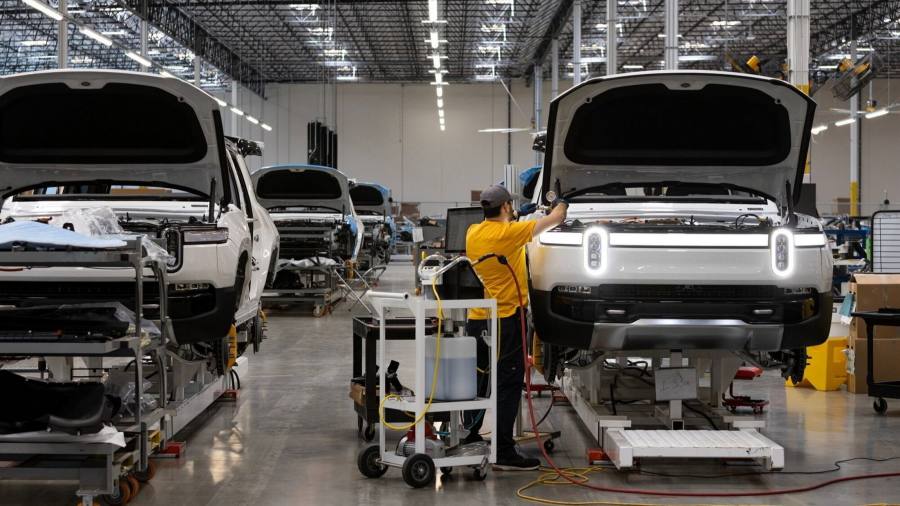US electric vehicle sales are gathering pace, hitting the 4mn mark at the end of June, according to data and analysis from consultancy Atlas Public Policy.
The sales are being driven by a combination of price cuts at Tesla and Ford this year, tax credits worth up to $7,500 for consumers and greater manufacturing capacity, experts say.
“There’s no doubt that the pie for EVs is getting bigger,” said Atlas founder Nick Nigro.
“More people that were buying combustion engines are buying EVs . . . Tesla’s sales are growing, but everybody’s sales are growing, and that’s the sign of a strong market.”
It took nearly eight years to sell the first 1mn battery-powered cars, trucks and vans in the US, a milestone hit in 2018. The 2mn mark took roughly 32 months, and the third million took approximately 15 months. The accelerating pace brought the 4 millionth sale after just 10 months.
Tesla, General Motors and Rivian all reported strong US sales and deliveries for EVs during the second quarter, as did BYD in China. EV sales declined 2 per cent at Ford in the second quarter versus a year earlier, but they were still up 12 per cent in the first half of the year compared to 2022.
Tesla makes up about 61 per cent of the market, compared to just over 4 per cent for GM.
For the time being, electrified cars and trucks remain the province of early adopters, with EVs comprising less than 10 per cent of new vehicle sales. The sense that they are mainstream only exists in pockets of the US market, like California, where nearly a quarter of new vehicle sales in the first three months of the year were electric.
Some players in the auto industry want to slow the electric transition. The Alliance for Automotive Innovation, a trade group that includes major carmakers, has said stringent US emissions standards proposed in April mark “a significant movement of the country’s electrification goalposts”. The United Auto Workers union said on Thursday that standards for EV adoption should be set “to feasible levels”, tightening “over a greater period of time”.
But rising sales mean more people are likely to know someone who owns an EV, said Jessica Caldwell, executive director of insights at Edmunds, and as “more vehicles hit the road . . . people will feel more comfortable with them”.
Sales of electric models, like the auto industry as a whole, are improving because as the supply chain crisis has eased, manufacturers are no longer struggling as much to obtain the parts necessary to build cars and trucks. New players in the industry, like Rivian, are also improving output as they move past the production problems that dogged their early days. The California company built almost 14,000 trucks in the second quarter, nearly 3,000 more than Wall Street expected.
Tesla also said recently that it will open its Supercharger network to owners of cars and trucks made by Ford, GM and Rivian. Anxiety over how far an EV can travel on a single charge is a persistent worry for US drivers, given the limited availability of fast public charging. Tesla’s network of 12,000 Superchargers represents about 60 per cent of the total fast chargers available to US EV drivers, according to Deutsche Bank analyst Emmanuel Rosner.
Discounts at Tesla and Ford have contributed to rising sales. Tesla delivered a record 466,000 cars between April and June after cutting prices in the US in January by up to $13,000 across models. This prompted Ford to price its Mustang Mach-E between $46,000 and $64,000. Tesla then lowered prices again in March, decreasing the starting price of the Model S by 5 per cent to about $90,000 and the cheapest Model X by 9 per cent to about $100,000.
Tax credits have also boosted EV sales, although it is unclear by how much. The Inflation Reduction Act, President Joe Biden’s signature climate change and industrial policy law, grants consumers up to $7,500 in tax credits. Consumers, Caldwell noted, are always interested “whenever there is free money at play”.
But the list of vehicles that qualify for the full tax credit is abridged based on whether it is produced in North America and on the origin of the materials used in the battery. Only 10 of the 68 EV models currently for sale in the US are eligible for the full credit. Three of those models are Teslas, after the law lifted the cap on receiving the credit after a carmaker had sold more than 200,000 EVs, a threshold Tesla passed five years ago.
The tax credits are helping demand for EVs, said Joe McCabe, chief executive at AutoForecast Solutions, but “honestly, who’s it helping? Tesla.”
That is the case for Quinton Gaines, a new Tesla owner in Clearwater, Florida. The Gaines family bought their Model Y last month after an abortive attempt to purchase a Ford Mustang Mach-E. Gaines said he wanted to buy an EV because the family wanted a second car, and he could not justify the carbon emissions of owning a second petrol-powered vehicle.
They ordered the Mach-E in November. No local dealerships had EVs on the lot, and Ford guaranteed them a six-month delivery window, Gaines said. But when the sport utility vehicle arrived in June, it malfunctioned during a test drive, losing power at a major intersection. A police officer arrived to help, Gaines said, and “the last thing the officer said is: ‘You may wish to reconsider your purchase’”.
The Model Y, he said, was the only vehicle he could find that he trusted to drive properly, was eligible for the full tax credit and could “haul four people and a bunch of chairs down to the beach”.
Carmakers are vying for attention and customers as the electric vehicle market develops, McCabe noted. “In the automotive space, not everyone can win,” and right now, it is “the Wild West out there”.
Read the full article here





